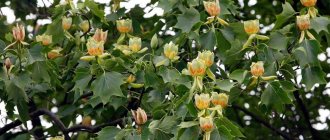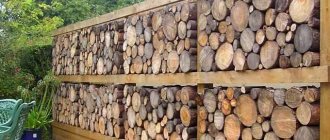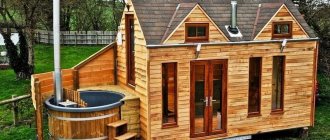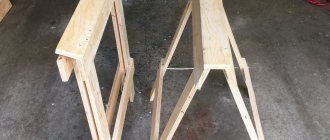Review author: Terrari School of Design
Organizing an artificial pond in a garden plot is a rather difficult task. There are many reasons for this: suboptimal soil condition, lack of free space, significant financial investments.
An alternative to a real pond or stream is a dry stream made of stones and sand. All the advantages of such an element of landscape design can be appreciated in the photo of a dry stream.
Advantages of a decorative element
Currently, the dry stream is very popular among garden owners, as well as in the art of landscape design. The most significant advantages of such decoration in the garden include:
- A minimum set of tools for organizing a dry pond.
- Much less effort and finances are required to arrange a garden stream.
- A wide range of possible dry stream designs: from a simple winding channel to a full cascade.
- A dry stream goes well with both a Japanese rock garden and green spaces, flower beds, gabions and other decorative elements of the garden landscape.
The owner of the site does not need to purchase equipment and medications to clean a dry stream, unlike a real reservoir.
Video description
Ready-made ideas for creating streams of flowers in the video:
Additional decoration
An already finished object can be additionally decorated with wooden bridges and stone slabs thrown across the riverbed. Garden sculptures placed along the stream and street lanterns look picturesque. They add a touch of romance and allow you to create an atmosphere of special comfort in the evening.
Wooden bridge over a dry stream Source landscapee.ru
Step-by-step creation of a decorative element
To create a beautiful dry stream with your own hands, you will need the following set of tools and materials:
- Sand, especially if there are not enough stones.
- River or sea pebbles. Today you can buy ready-made stone, cut for the construction of a dry stream.
- Pegs and cord for marking the territory.
- A shovel is useful for removing the surface layer of soil.
To prevent the growth of weeds, it is necessary to lay geotextiles, so care should be taken to ensure its availability at the preparatory stage.
Preparing the area for the stream
The next DIY step is to prepare the area for the dry stream. This design is a very popular design element, however, placing it in the wrong place can spoil the overall appearance of the garden landscape.
To select the optimal location for the stream, it is better to use graphic design programs or make a drawing that will display the following parameters:
- Size and length of the stream.
- The location of other landscape elements, including green spaces, flower beds, alpine slides and bridges.
The drawing (in the absence of artistic skills, it can be a schematic sketch) must necessarily show the ratio of the area occupied by the stream and the sizes of other decorative elements.
Preparing the foundation for the stream
The next task of the master is to prepare the foundation. It is not enough to simply lay a stone on a selected area of soil. Any decorative element must be durable, forming a reliable component of the garden landscape.
Instructions on how to prepare a site for a future dry stream with your own hands:
- Based on the prepared project plan, the territory is marked. To mark the boundaries of the proposed channel, wooden pegs and a textured cord are used.
- The top layer is removed from the soil. To make a decorative stream, you will need to remove only 15-20 cm of soil.
- The bottom and walls of the resulting trench are leveled, all roots, grass, and sprouts are removed, which, if actively growing, can disrupt the decorative composition.
- Geotextiles are placed at the bottom to prevent excessive growth of vegetation.
It should be remembered that laying waterproofing material on a rocky surface is carried out only after arranging a sand cushion on the bottom. The sharp edges of the stones can damage the fabric, rendering its basic functions ineffective.
Digging moment
You can safely dig, just remember right away that the walls of the recess should be at an angle of no more than 50 degrees. When digging, throw away the weeds, preferably along with the roots.
Laying stones in the riverbed
The main stage of construction work consists of laying the rocky stream. All actions are carried out in accordance with the prepared plan. The size and type of stones determine the appearance of a dry stream for your garden landscape. Most often, large pebbles are placed on both sides of the channel, and the rocky stream itself is lined with small gravel or river stones. As an original addition, you can “dilute” the flow with several large boulders. It should also be remembered that the design of a dry stream necessarily includes a source. A beautiful clay pot, a broken ceramic bowl, or a waterfall made of boulders are often used as a source of a stream.
Pond with a bridge
To build a bridge over a stream, only natural wood is suitable. If there is an unused log in the yard, this is what you need.
If you don’t like this option, you can make a crossing with your own hands. Or you can leave it as is and lay stones on the surface.
Choosing vegetation for a stream
A dry stream in the garden looks great in combination with other landscape elements, such as beautiful flower beds. Criteria for optimal plant selection:
- Location of the stream on the ground.
- Level of lighting and soil moisture.
- The ability of the selected plants to grow excessively. Ornamental shrubs whose roots or shoots can quickly destroy the rocky bed, deforming it, should not be used for planting.
- From the art of landscape design, there are also a number of rules. An artificial stream made of pebbles does not at all combine with bright, saturated plants. To make an advantageous accent on the riverbed itself, it is important to select shrubs with beautifully colored foliage, but without lush inflorescences.
Coniferous plants give a dry pond an excellent appearance: junipers, low-growing thujas.
Such plants should be planted at a short distance from the riverbed itself, so that the overgrown roots do not damage the textile layer and stone laying.
Care
A properly maintained stream will not require much effort to care for it. It will be enough to trim the grass on the bank and weed the plants.
In hot weather, the stones will have to be watered so that they do not dry out the ground around too much. High humidity can lead to the appearance of moss, so the stones will have to be turned over occasionally.
Ants may choose a stream as a new home, so it will need to be periodically sprayed with special products.
A nice design will help to decorate the area in an original way and cover up not the most beautiful places, causing the white envy of neighbors and passers-by.
Original decor ideas
A dry stream goes well with other decorative elements. This could be an original bridge made of wood. A set of garden furniture, for example, a table and chairs for a dining area, can also be made from solid wood.
Along the stream itself, beautiful jugs, figurines, and plaster figurines are placed (any material that is resistant to moisture is welcome). The style of a dry stream will be favorably emphasized by an LED light installed along the riverbed.











